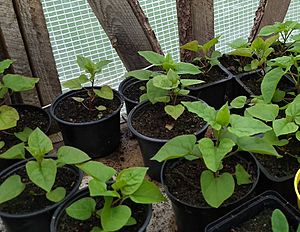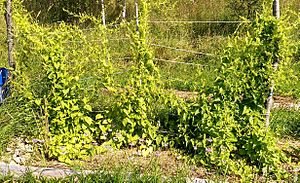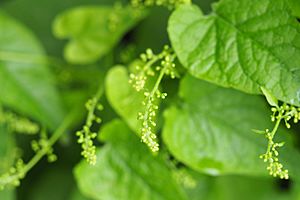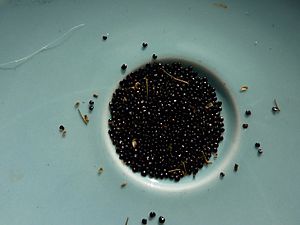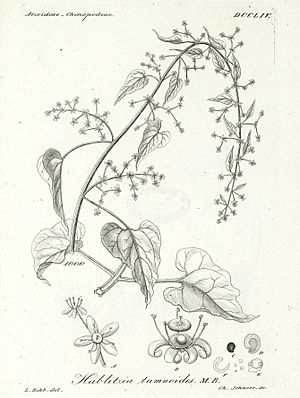Caucasian spinach facts for kids
Quick facts for kids Caucasian spinach |
|
|---|---|
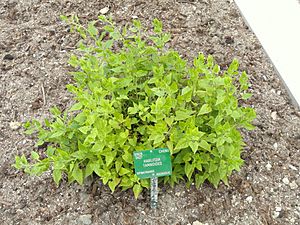 |
|
| Scientific classification | |
| Genus: |
Hablitzia
|
| Species: |
tamnoides
|
Hablitzia tamnoides, also known as Caucasian spinach, is the only plant in its group, called Hablitzia. It is a plant that grows back every year (a perennial) and has soft, non-woody stems (an herbaceous plant). This plant is originally from the Caucasus area.
Caucasian spinach belongs to the Amaranthaceae family, which includes plants like spinach and beets. However, unlike many of its relatives, Hablitzia tamnoides is a vine. It can climb very high, reaching 3 meters (about 10 feet) or more in the summer! It's one of the few climbing plants in its family. Some plants have even lived for over 50 years, showing how long-lasting they can be.
Contents
About Caucasian Spinach
Leaves and Stems
Caucasian spinach has green leaves shaped like hearts. They are often a bit crinkled but don't have jagged edges. The leaves narrow to a point and sometimes have very soft, silky hairs. The surface of the leaves is usually dull, not shiny. The veins on the leaves spread out from a single main line.
The stems are usually green and have clear ridges running along them. They can sometimes have a reddish color. The leaves are safe to eat and taste similar to regular spinach.
Flowers
The flowers of Hablitzia are quite small. They are a lighter green than the leaves, sometimes yellowish-green. Each flower looks like a tiny five-pointed star. In Norway, the plant is even called "Star-chenopod" because of its star-shaped flowers.
These flowers grow in large clusters and appear from late May through July. They have a special smell. Individually, the scent is not strong, but if you get close to a plant with many flowers, you might notice a smell like crushed coriander (cilantro) leaves. Some people find this smell unpleasant. This is interesting because some people dislike coriander due to a specific gene that makes them sensitive to certain chemicals found in it. Perhaps Hablitzia flowers have similar chemicals. The flowers have both male and female parts.
Seeds
Hablitzia produces many tiny, shiny black seeds.
Roots
In autumn, the parts of the plant above ground die back. However, the main part of the Hablitzia plant stays either above or very close to the ground. Even in winter, you can usually find small buds or shoots at the base of the old stems. These buds usually stay asleep until around February. There are often smaller, backup buds around the main shoots. These are ready to grow if the first shoots get damaged or eaten. Sometimes, the plant's crown (the top of the root system) can rise out of the ground. This shows its thick, fleshy roots, which look a bit like those of sea kale.
Plant Height
Hablitzia plants can easily grow to about three meters (nearly 10 feet) tall if they have something to climb on. They don't have special parts like tendrils or suckers to help them climb. Instead, they climb mostly by twisting their leaf stalks around other plants or structures. This is similar to how some types of Clematis plants climb. If there's nothing to climb, they are happy to spread out on the ground or hang over the edges of pots or raised garden beds. In their natural homes, they have even been seen hanging over the entrances of caves!
Natural Home and Growing Needs
As its common name, Caucasian spinach, suggests, this plant comes from the Caucasus region. It grows there at high places, up to about 2,100 meters (nearly 7,000 feet) above sea level. Most reports say it is found in dry forests, especially in shady spots, among rocks, in deep valleys, and along rivers.
While most plants in its family like full sun, Caucasian spinach prefers shade. This is like its cousin, Good King Henry. Its love for shade is also seen in its connection to caves. One person found plants covering half the floor of a cave in the mountains of Armenia!
Besides the Caucasus, Hablitzia has also been found in northeastern Turkey, where it has started growing on its own. It's also been seen further east in Iran and west in Greece. There are also small groups of these plants scattered across Scandinavia (Sweden, Finland, and Norway). This shows the interesting history of Hablitzia.
History of Hablitzia
Hablitzia began its journey from the Caucasus across Europe in the early 1800s. It was grown in the UK at famous gardens like Kew and Cambridge Botanical Gardens as early as 1828. This was only 11 years after it was first described by scientists! It was also grown in Glasgow around 1838. These British gardens were among the first to grow Hablitzia. It wasn't until the second half of the 19th century that more gardens started growing it regularly.
Naming the Plant
The plant was first officially described by Friedrich August Marschall von Bieberstein. He gave it its scientific name, Hablitzia tamnoides. The name Hablitzia comes from Carl Ludwig Hablitz, a scientist from the 1700s. The second part of the name, tamnoides, means "like" or "resembling" another plant called Tamus communis.
How People Use Hablitzia
For Eating
You can eat Hablitzia leaves raw or cooked. The young leaves are especially tasty. Even older leaves are good to eat and don't become bitter. However, older leaves from plants grown in full sun, especially if they haven't had enough water, are usually better cooked.
Besides the leaves, you can also eat the young shoots, tender vine tips, and new flower parts. These can also be eaten raw or cooked. The shoots are best when harvested from the plant's base before they start growing much. At this stage, the undeveloped leaves are tightly packed, making them a bit more substantial, like asparagus. Early in the season, these shoots are often a beautiful magenta color. You can cook them simply, perhaps sautéed in butter with a little lemon juice, salt, or pepper. They are delicious!
It is not known if the seeds and roots of Hablitzia are safe to eat.
Nutrition Facts
Until recently, not much was known about the nutrition of Hablitzia. However, a study in Finland found some interesting facts. Hablitzia leaves are rich in important nutrients like carotenoids, folates, calcium, magnesium, phosphorus, and zinc. They also have safe levels of things like oxalic acid and nitrates.
The study also compared Caucasian spinach to New Zealand Spinach. It found that Hablitzia had higher amounts of carotenoids, folate, healthy fats (Omega-3), protein, and most minerals.
Hablitzia also contains special compounds called betacyanins. These are what give the stems and leaves any red color you might see. Beetroot and other plants in the same family also have these compounds.
For Decoration
Hablitzia is a beautiful plant to grow for its looks. It's a climbing vine with many small white flowers and nicely shaped leaves.
Growing Hablitzia
Where to Plant It
Hablitzia can handle a good amount of shade. In fact, it seems to prefer partial shade. It especially likes to have its roots in the shade. This helps the soil stay cool and moist during the hottest parts of the year. Plants can grow in full sun, but they need a lot of water. Otherwise, weeks of strong summer sun can make the leaves less appealing.
How Cold It Can Get
Many Hablitzia plants grown today come from Scandinavia. This means they are very good at surviving cold weather. Some plants in northern Norway can even survive temperatures as low as -30 degrees Celsius (-22 degrees Fahrenheit)! In its natural home in the Caucasus, some Hablitzia plants grow at high altitudes, so they are also quite hardy.
Soil Needs
Caucasian spinach can grow in different types of soil. However, it grows best in a good, rich, loamy soil.
Water Drainage
Two very important things for Hablitzia are good drainage and the soil's pH level. Even though Hablitzia likes a lot of water when it first starts growing, it doesn't like its roots to be wet in winter. It's important to keep the roots dry during the colder months. Too much moisture in the soil during winter can kill the roots.
Soil pH
Hablitzia seems to prefer soil that is neutral or slightly alkaline (not too acidic). This makes sense because many plants in its family grow well in soils with higher levels of certain salts. It can do okay in slightly acidic soil (around pH 5), but if the soil is too acidic, it might not grow well.
Climbing Support
While not absolutely necessary, most people like to give Caucasian spinach something to climb on. A large trellis, garden obelisk, or a bean pole wigwam works well. Older gardening books even suggest using it to cover an arch or a pergola.
Perhaps the most satisfying way to support Hablitzia is to use a living trellis. You can plant it at the base of a tree, especially a tree that loses its leaves in winter. This way, the new shoots get extra light early in the year. The plant's slender stems can cling to the tree trunk and grow its beautiful green flowers. You can also try planting it next to large, bushy shrubs.
Pests and Diseases
Hablitzia is not known to have many problems with pests or diseases. However, it can be a host plant for a type of beetle called Cassida seraphina var. hablitziae, which is found in Turkey and Kazakhstan. Also, in some studies, plants were successfully infected with a leaf spot virus. There is also some idea that in warmer places, high humidity, especially in the hottest parts of the year, can make the plants unhealthy or even kill them.
How to Grow New Plants
From Seeds
You can grow Caucasian spinach from seeds or by dividing existing plants. Both ways are fairly easy. Fresh seeds usually sprout easily. They sprout more evenly and quickly when planted outside when temperatures are still cool, like in March and April. Usually, you don't need to do anything special to the seeds before planting. However, some people find that a short period of cold storage can help them sprout better. When planting Hablitzia seeds, sprinkle them on top of a mix of compost and sand. Then, cover them with a thin layer of small stones (horticultural grit).
People who have grown plants from seeds collected in the wild say that these seeds might not sprout as reliably or might take longer to sprout.
Hablitzia flowers have both male and female parts, and the plants can produce seeds on their own. However, some plants might produce more seeds if there are two or more different plants growing close together. Mature Hablitzia plants often drop their own seeds, and new seedlings will grow. But these young plants can be eaten by slugs and snails. It's not fully known how long Hablitzia seeds can stay good for planting. However, one report said that seeds stored for about four years still sprouted successfully.
From Plant Parts
When it comes to growing new Hablitzia plants from existing ones, you have a couple of choices. One way is to dig up and divide established plants. You would do this just like you divide other plants that grow in clumps. The best time to do this is after the current year's growth has died back, or early the next season before new growth starts.
You can also grow new plants from cuttings. Take shoots from the base of the plant with a small piece of the main stem attached. Do this just after they start growing in early spring. Remove the lowest leaves, put a little liquid rooting hormone on the cut end, and place them in sandy compost. Keep them in a cool, sheltered spot away from direct sunlight. Plants grown from cuttings might not grow very strongly in their first year. But by the end of autumn, you should see 5 to 10 buds at the base of the plant, ready to grow the next season. It's not clear if you can grow Hablitzia from root cuttings.
Plants in their first year grow quite slowly. For the best long-term results, it's a good idea not to harvest too much from them until their second year. By then, the plants will be much stronger and grow more vigorously.
Images for kids
See also
 In Spanish: Hablitzia tamnoides para niños
In Spanish: Hablitzia tamnoides para niños


